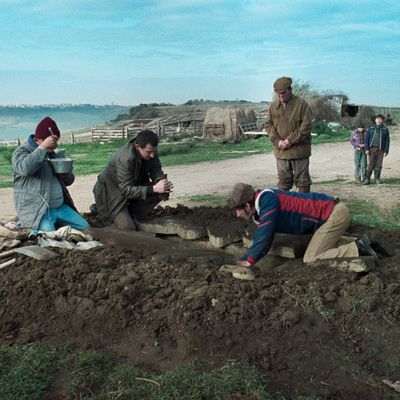
Alice Rohrwacher’s La Chimera begins with a dream — and it’s entirely possible the dream never really ends. The film follows Arthur Harrison (Josh O’Connor), a strange man with a strange gift for robbing graves, for finding and lifting the antique knickknacks the ancient Etruscans of central Italy used to bury with their dead. “These are not meant for human eyes,” runs a refrain in the movie, and the reluctant, withdrawn Arthur himself might agree. A former archaeologist, he seems haunted by his own exploits, and this occasionally rambling, often gorgeous film’s queasy dream logic suggests that we’re watching a man halfway between this world and the next, struggling to find his place.
Even Arthur’s costuming sets him apart: His white linen suit appears at first to be the wardrobe of an aloof aristocrat, but over the course of the picture we see how ratty and grimy it really is. He lives in a makeshift shack — you can’t really call it a home — built against the ramparts of an old town, but he spends more time, it seems, in the elegant villa belonging to Flora (Isabella Rossellini), an aging matriarch and music teacher and the mother of the oft-mentioned, mostly unseen Beniamina, a long-lost love of Arthur’s. The rest of his time is spent with his merry band of tombaroli, a lively group of impoverished local tomb raiders who sell their wares to a mysterious, all-knowing merchant known as Spartaco. (To be clear, they’re merry; Arthur is not.)
Rohrwacher, one of Italy’s foremost filmmakers, makes earthy movies with a dash of what we might call magical realism. The performances are naturalistic, the location shooting authentic and ground level, but the stories often hover on the edge of fantasy. The director fills the picture with folk ballads, naïf art, playful asides to the camera, and bursts of sped-up slapstick, giving it all the quality of a ramshackle operetta.
But O’Connor’s concave, melancholy demeanor undercuts the picture’s levity, likely by design; the more the film goes on, and the more fanciful it becomes, the more Arthur seems at odds with everything around him. A burgeoning relationship with a vivacious young woman named Italia (Carol Duarte), a servant-student who lives with Flora, promises an emergence into the light, but it also underlines just how irreconcilable Arthur might be with this world. He spends his life digging up objects meant for the beyond not because he wants to exploit them but because he wants to commune with them. “He was looking for a passage to the afterlife,” someone opines. He’s a sad, walking embodiment of the notion that those who spend their lives worrying about the next life will never feel peace in this one.
La Chimera often recalls the work of Rohrwacher’s Tuscan compatriots, the late Paolo and Vittorio Taviani, most notably in a scene during which an argument between the tombaroli and one of their patrons descends into animal noises and inchoate grunts. We can also see nods to the work of Pier Paolo Pasolini and Federico Fellini, filmmakers who regularly mined the collision between postwar Italy’s boom-and-bust cycles and the stony solidity of its classical heritage. La Dolce Vita’s immortal opening sequence of a statue of Christ being pulled out of some ruins by helicopter and flown over a modern cityscape gets its own small homage here with the spectacle of an ancient statue, found in the shadow of a power plant, being boxed up in a shipping container. Rohrwacher is a singular artist, but La Chimera is still rich with such allusions and evocations. At times, it feels as though it has emerged — dusty, tattered, and beautiful — from the storied earth of Italy itself.
More Movie Reviews
- The Accountant 2 Can Not Be Taken Seriously
- Another Simple Favor Is So Fun, Until It Gets So Dumb
- Errol Morris Has Been Sucked Into the Gaping Maw of True Crime


